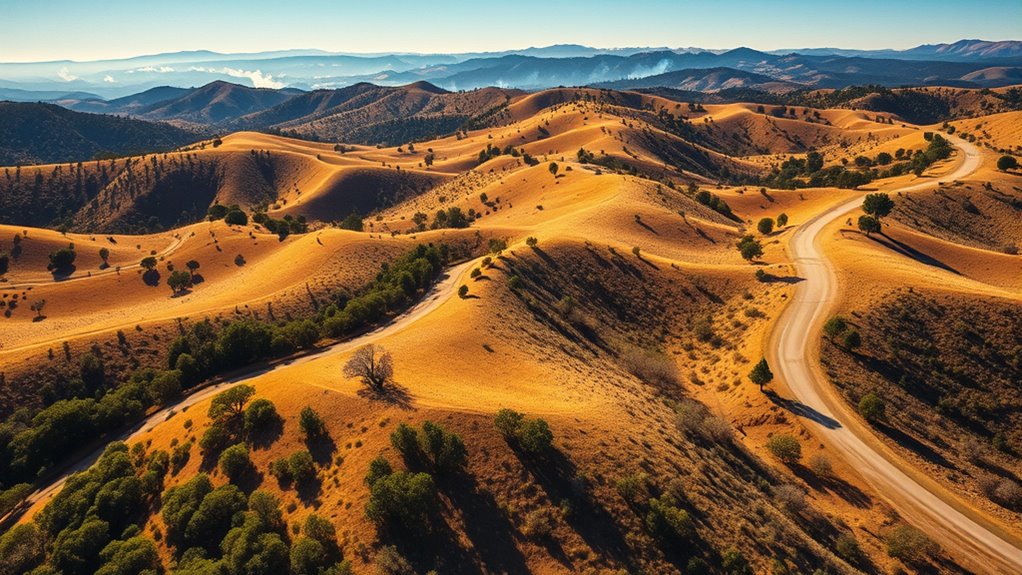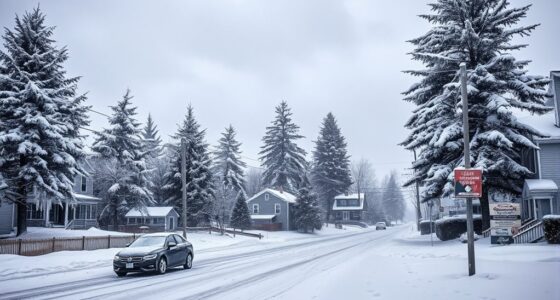In California’s Mediterranean climate, effective wildfire risk management involves implementing prescribed burns to reduce excess vegetation and create buffer zones around your property. Community education is essential to understand these controlled fires and encourage proactive measures like clearing defensible space and developing emergency plans. Combining these strategies with active outreach and mindfulness helps build resilience. If you keep exploring, you’ll discover how integrated efforts can protect you and your community from wildfires.
Key Takeaways
- Prescribed burns are used to reduce fuel loads and mimic natural fire cycles, decreasing wildfire severity.
- Community education fosters understanding and support for fire mitigation strategies like prescribed burns.
- Promoting defensible space and emergency planning enhances individual and neighborhood wildfire resilience.
- Integrating prescribed burns with outreach and community participation strengthens comprehensive wildfire risk management.
- Mindfulness and mental health practices help residents manage stress related to wildfire risks and preparedness efforts.

Have you ever wondered how communities can effectively reduce the devastating impact of wildfires? One of the most proven methods is through prescribed burns, which are carefully planned and controlled fires set intentionally to clear out excess vegetation. These burns mimic natural fire cycles, helping to reduce fuel loads that could otherwise become dangerous during a wildfire. When done correctly, prescribed burns can create a buffer zone around neighborhoods and critical infrastructure, making it less likely that a wildfire will spread rapidly through these areas. But prescribed burns alone aren’t enough. To truly succeed, communities need to invest in robust community education programs that inform residents about the purpose and safety of these practices. When people understand that prescribed burns are controlled and beneficial, they’re more likely to support them and cooperate during fire management efforts. Education also helps dispel misconceptions, reducing fear and resistance that can delay or hinder necessary fire mitigation activities.
Community education should be ongoing, reaching residents well before fire season begins. Workshops, informational campaigns, and neighborhood meetings can explain how prescribed burns work and their importance in wildfire risk reduction. When community members understand the science behind these burns and see that they’re conducted by trained professionals, they often feel more confident and willing to support fire management plans. Additionally, education fosters a sense of shared responsibility. When residents know how to create defensible space around their homes—such as removing dead vegetation, maintaining proper landscaping, and installing fire-resistant materials—they contribute to a collective effort that substantially reduces wildfire danger. Education also encourages preparedness, urging people to develop emergency plans and stay informed through alerts and updates.
In many California communities, combining prescribed burns with active outreach has proven effective. These efforts are especially essential given the state’s Mediterranean climate, which naturally supports dry summers and wet winters, creating ideal conditions for fires to ignite and spread. By integrating prescribed burns into a thorough wildfire risk management plan and coupling them with community education, you empower residents to participate actively in fire prevention. This dual approach not only diminishes fuel loads but also builds resilience and confidence within the community. When everyone understands the role they play—whether through supporting prescribed burns or implementing defensible space—the collective effort becomes more coordinated and impactful. An understanding of mindfulness practices can also help residents manage stress and anxiety related to wildfire threats, contributing to a more composed and prepared community. Ultimately, reducing wildfire risk isn’t just about fire suppression; it’s about fostering an informed, prepared, and engaged community that recognizes the value of proactive strategies like prescribed burns and education.
Frequently Asked Questions
How Does Climate Change Influence Wildfire Frequency in California?
Climate change increases wildfire frequency in California by amplifying climate variability and drought intensity. You’ll notice longer, hotter droughts that dry out vegetation, making it more flammable. Rising temperatures also create more extreme conditions, leading to more frequent and intense wildfires. As droughts become worse and climate variability grows, you’ll see wildfires happening more often, putting communities and ecosystems at greater risk.
What Role Do Local Communities Play in Wildfire Prevention?
You play a crucial role in wildfire prevention by actively engaging with your community and supporting local policies. While flames threaten homes and landscapes, your participation in community programs fosters awareness and preparedness. By advocating for responsible land management and fire-safe practices, you help protect lives and property. Your involvement transforms fear into action, turning a collective threat into a united effort to reduce wildfire risks and build resilient neighborhoods.
How Effective Are Current Wildfire Prediction Models?
You’ll find that current wildfire prediction models are quite effective at estimating fire behavior and improving response times, but their modeling accuracy still has room for improvement. They help you anticipate how fires spread based on weather, terrain, and vegetation. While they’re valuable tools, unforeseen factors can affect fire behavior, so staying vigilant and combining models with local knowledge enhances overall wildfire management efforts.
What Are the Long-Term Ecological Impacts of Wildfires?
You’ll notice that wildfires can cause long-term ecological impacts like altering fire-resistant vegetation and increasing soil erosion. Fire-resistant plants may struggle to recover, changing plant communities, while soil erosion can degrade habitats and reduce water quality. These effects can persist for years, making it essential to implement strategies that promote ecological resilience and protect critical ecosystems from future fires and their lasting consequences.
How Can Homeowners Better Prepare for Wildfire Season?
Think of preparing for wildfire season like building a fortress around your home. You should create a defensible space by clearing dead vegetation and maintaining your yard. Develop an emergency preparedness plan, including evacuation routes and emergency kits. Regularly review and update these plans, and stay informed about fire alerts. Staying proactive guarantees you’re ready to defend your home and loved ones when wildfire danger strikes.
Conclusion
As you navigate California’s Mediterranean climate, managing wildfire risk is like tending a delicate garden—you must stay vigilant and proactive. By understanding the unique landscape and employing strategic measures, you can help prevent fires from spreading out of control. Remember, each action you take is a thread in the larger fabric of community safety. Together, you can weave a resilient future, where wildfire risks are tamed like wild horses, rather than wildfires running free.










